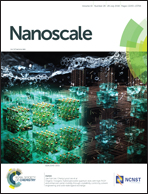Ultra-stretchable and highly sensitive strain sensor based on gradient structure carbon nanotubes†
Abstract
High stretchability and sensitivity of strain sensors are two properties that are very difficult to combine together into one material, due to the intrinsic dilemma of the opposite requirements of robustness of the conductive network. Therefore, the improvement of one property is always achieved at the expense of decreasing the other property, and preventing its practical application. Inspired by the micro-structure of the copolymer, which consists of stretchable amorphous and strong crystal domains, we developed a highly stretchable and sensitive strain sensor, based on innovative gradient carbon nanotubes (CNTs). By integrating randomly oriented and well aligned CNTs, acting as sensitive and stretchable conductive elements, respectively, into a continuous changing structure, our strain sensors successfully combine both a high sensitivity (gauge factor (GF) = 13.5) and ultra-stretchability (>550%). With a fast response speed (<33 ms) and recovery speed (<60 ms), lossless detection of a 8 Hz mechanical signal has been easily realized. In addition, the gradient CNTs strain sensors also showed great durability in a dynamic test of 12 000 cycles, as well as extraordinary linearity and ultra-low working voltage (10 mV). These outstanding features mean our sensors have enormous potential for applications in health monitoring, sports performance monitoring and soft robotics.



 Please wait while we load your content...
Please wait while we load your content...